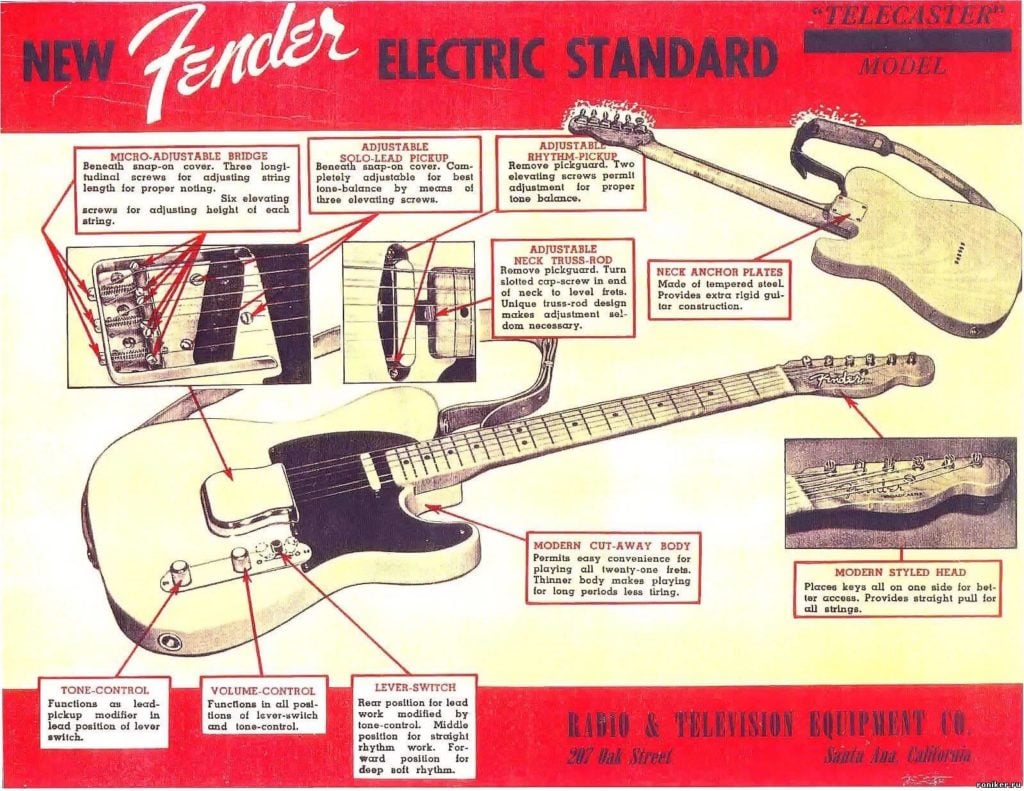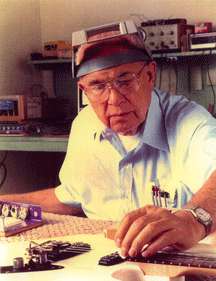In June 2019, an electric guitar known as “The Black Strat”—played for decades by Pink Floyd’s David Gilmour—was auctioned for a little less than $4 million, making it the most expensive guitar ever sold.1 Emblazoned on its headstock is the name “Fender,” after its late designer, Leo Fender, who never learned to play or even tune a guitar but who undoubtedly changed the course of music history.
Leo was an unlikely character to revolutionize music. He was a quiet kid, even more so after losing an eye in a childhood accident. But the gears of his mind turned at the sight of any unfamiliar contraption, including, at age ten, the first car he’d ever seen—which he promptly crawled under for a view of its mechanics. By the time he was in high school, he was repairing radios and had built an antenna atop his parents’ barn, where he had been born a little more than a decade earlier on August 10, 1909.
His glass eye kept him out of the military during WWII, by which time he had opened Fender Radio and Record Shop.2 He would often note design flaws in the instruments and amplifiers musicians brought in for repair. Instead of merely fixing them, he made them more reliable and better sounding than they’d ever been—and musicians took note. By the mid-forties, several public address systems (PAs) he had built were being rented out almost continuously, and he’d sold a few as well. He began building amplifiers, and by the late 1940s, the most popular band west of the Mississippi, Bob Wills and his Texas Playboys, would use none other.3
Hollow-body guitars had long been a component of the day’s popular jazz and Western swing bands. Fighting to be heard among large ensembles, some players had outfitted their instruments with magnetic pickups and amplified the sound—often startling themselves and their audiences with large swells of feedback. All-star guitarist Les Paul had solved the problem back in 1941 by attaching a standard (then known as a “Spanish” style) guitar neck, strings, and pickup to a block of wood.4 The solid wood body didn’t resonate sympathetically with the amplified signal as did a hollow body, enabling Les to crank his volume without fear of a piercing shriek. But Gibson—the guitar company that endorsed him and built the hollow bodies he played—laughed off the idea of producing a solid-body guitar.5 Gibson’s luthiers were highly skilled artisans who crafted instruments by hand and ear. The idea of slapping some boards together and adding strings was anathema.
By 1943, Leo independently had come up with a similar solution. The steel guitars he’d been building with his partner, Doc Kauffman, had solid bodies, and one evening they attached a standard guitar neck to a similar block of wood mounted with pickups. Players were drawn to Leo’s little experiment, but he had yet to see it as anything more.
Deciding that manufacturing amps and steel guitars was a better business than repairing them, he opened Fender Electric Instrument Company in 1946. The electronics whiz couldn’t have imagined the challenges ahead. Orders were slow. Wood rotted as production crawled, or—lacking proper storage—was too wet for paint to adhere to. The instruments that found their way into stores buzzed loudly if they made a sound at all. Leo took out loans, dodged creditors, and drew on the paycheck his wife got from her day job to pay his employees. But, gradually over the next few years, he and his team gained experience and improved.
After a day’s work in the sheds that then made up his “factory,” Leo would visit dance halls, either to operate one of his PAs or to put his best instruments into the hands of Southern California’s standout players. While preparing a PA one evening, he saw country guitarist Merle Travis walk in with an instrument that would forever alter his perspective. Like his and Les Paul’s earlier experiments, this guitar combined a fully solid body with a standard guitar neck. Unlike either, it was gorgeous, shaped like an acoustic guitar but thinner. Paul Bigsby had built it by hand over several months, alone in his home workshop—just as he had each of the prohibitively expensive steel guitars he custom built for established musicians.
Hearing how fast and clear Travis could play it, Leo knew instantly that solid-body guitars were the future: not the ornate thing now before him, but a purpose-built tool that any musician could afford and any professional could rely on. He soon hired George Fullerton, a guitar player with woodworking experience, and by 1949, they were stopping by saloons with prototypes, letting players try them and soliciting ideas for improvements.
In 1950, at Chicago’s National Association of Music Merchants (NAMM) tradeshow, Fender sales chief Don Randall unveiled their work—a guitar he dubbed the Esquire. His peers in the business had other names for it, such as “canoe paddle” and “toilet seat.”6 But as steadily as they mocked the simplified and affordable guitar, musicians and dealers placed orders. Leo had barely eked out a few prototypes in time for NAMM, and now, as orders piled up, he halted production, not content with the design. Only eighteen months later would Fender begin filling the back orders, and then with a significantly improved instrument—first named the Broadcaster, then (after a competitor complained the name infringed its trademark on “Broadkaster” drums) renamed the Telecaster.7
All the while, Fender also was working on another problem, and he invented an entirely new instrument in the process. Among gigging musicians today, drummers—who have little choice but to lug loads of heavy gear—are common objects of pity. But in the early 20th century, bassists had no choice but to play massive, bulbous upright basses and so were in a similar position. That was, until Fender applied the solid-body concept to the bass, creating the first-ever electric bass guitar: a relatively inexpensive and portable instrument that—when paired with an amp—provided louder, tighter-sounding low end than any upright bass. Fender also gave the instrument frets like those of standard guitars, enabling guitarists to transition quickly to bass and anyone to play with greater precision than on an upright. Thus, Leo called it the Precision bass, and it quickly became the go-to for top-notch players, including James Jamerson, whose bopping low end became the foundation for the “hit factory,” Motown Records.
In 1952, Fender followed the electric bass with the Bassman—the first amp ever designed specifically for bass guitars—and in 1954, the now-iconic Stratocaster, a guitar with a comfortably contoured body that “hugs” players.8
Leo contracted a strep infection in the mid-fifties but labored on, continuing to innovate throughout the decade and into the next. He couldn’t imagine the music his electrified instruments would soon make possible, and although he loved musicians, he didn’t care for the more aggressive rock ’n’ roll that had begun replacing his favored country and Western. Despite the many treatments his doctor tried, his infection lingered for years while the tiny instrument company morphed into an empire. In 1965, believing his health required it, Leo and longtime partner Don Randall sold the company to Columbia Broadcasting System (CBS) for $13 million.
Quality plummeted under CBS management, and guitar and bass players came to regard “pre-CBS” Fender instruments as the gold standard.9 These early Fenders skyrocketed in value and became the mainstays of many renowned players. Jeff Beck gifted a 1959 Telecaster to Jimmy Page, who played it in the Yardbirds, then on Led Zeppelin’s first album, and later, on the solo in the legendary rock composition “Stairway to Heaven.”10 Keith Richards’s girlfriend, Linda Keith, supposedly stole his mid-sixties Stratocaster and gifted it to the as-yet-unknown Jimi Hendrix, who was withering as a sideman and borrowing guitars because he didn’t own one.11 In 1977, another unknown guitar player picked up a red 1961 Stratocaster, the sound of which led him to completely rework a song he’d written. “It just came alive as soon as I played it on that ’61 Strat. . . . the new chord changes just presented themselves and fell into place,” says Mark Knopfler, reflecting on the Dire Straits song “Sultans of Swing.”12 The song peaked at number 4 on the Billboard Hot 100 chart in the United States, launching Knopfler’s music career, which is still going strong more than forty years later.13 A fleet of early-1960s Stratocasters also powered the adrenaline-soaked blues of one of the greatest guitar players of all time, Stevie Ray Vaughn. Musicians everywhere considered such instruments to be the holy grail.
One man, however, remained unconvinced that pre-CBS Fender instruments couldn’t be improved upon: Leo Fender. Within a few years of selling his company, he found a doctor whose treatment some have said “skirted the edge of legitimate medicine.”14 In any case, it worked. The life of a retired multimillionaire didn’t suit Leo, and he was itching to get back to his workbench. Country star Buck Owens once said of him, “I’ll bet that’s what Einstein did, never letting go of a problem till he had an answer, never satisfied that his work couldn’t be made better.”15
In 1971, two former Fender employees launched a new instrument manufacturing company, of which Leo would become president in 1975 (after his non-compete with the CBS-owned Fender company ended). Here at Music Man, Leo pioneered built-in active frequency equalization on bass guitars, which gave the instruments unprecedented tonal control. Along with Tom Walker, he also designed a new class of hybrid amplifiers that many stars found appealing, including Glen Campbell, James Burton, Emmylou Harris, and Eric Clapton.16
In 1979, the company imploded over a rift in management, but the following year, Leo was back at it. He and George Fullerton—whom he’d first hired back in 1948—established G&L Musical Instruments. “My partner and I made the world’s most famous guitar,” said Fullerton, “then we set out to make the best.”17 In his last decade, Leo continued to innovate, giving musicians modern tools that integrated his nearly fifty years of guitar-building expertise. Dale Hyatt—who’d joined Fender as a sales rep in 1946, then G&L in 1980—said that Leo “was in here working, like he was most days, till 5 o’clock Wednesday, the day before he went. He had that perseverance, continuing and continuing on a problem until the damn thing worked.”18 And he couldn’t have been happier than he was doing just that. Though he never sought the spotlight, Leo Fender’s creations opened the stages of the world to countless players—and continue to do so today.
You might also like
Endnotes
1. Julia Gray, “David Gilmour’s Black Strat Breaks the Record for Most Expensive Guitar Sold at Auction,” Stereogum, June 20, 2019, https://www.stereogum.com/2048591/david-gilmour-black-strat-break-record-most-expensive-guitar-auction/news/.
2. He opened the shop in 1938.
3. Ian Port, The Birth of Loud: Leo Fender, Les Paul, and the Guitar-Pioneering Rivalry That Shaped Rock ’n’ Roll (New York: Scribner, 2019), loc. 323; Port’s book is an excellent history of the creation and evolution of the electric guitar and bass, and of the musicians who used them.
4. “The Log Heard ’Round the World,” Epiphone, March 14, 2018, http://www.epiphone.com/News/Features/2017/The-Log-Heard-Round-the-World.aspx.
5. Gibson did release a solid-body electric guitar, the Gibson Les Paul, in 1952, in response to the success of Fender’s solid-body electric guitar, which was released in 1950 and is discussed below.
6. Jim Washburn, “Leo Fender: His Contribution Struck a Chord Around World,” Los Angeles Times, March 23, 1991, https://www.latimes.com/archives/la-xpm-1991-03-23-ca-653-story.html.
7. After receiving a cease and desist letter from lawyers at the instrument company Gretsch, someone at the Fender factory cut “Broadcaster” off the Fender headstock decals, leaving only “Fender.” These guitars, which shipped for a brief period in 1951, came to be called “Nocasters,” because they lacked a model name, but they are essentially Telecasters.
8. The Bassman has undergone numerous iterations, most of which also have become favorites among guitar players.
9. In 1985, president of CBS’s Fender division William Schultz convinced CBS to sell the company to a management group he led. The new company, Fender Musical Instruments Corporation, quickly changed course, and by the mid-1990s, was producing quality instruments and had grown exponentially in value. See “Fender Musical Instruments Company History,” Funding Universe, http://www.fundinguniverse.com/company-histories/fender-musical-instruments-company-history/ (accessed August 5, 2019).
10. Jon Wiederhorn, “Dragon Slayer: The Magical Mystery of Jimmy Page’s Painted Telecaster,” Fender, https://www.fender.com/articles/gear/chasing-the-dragon-the-magical-mystery-of-jimmy-page-s-painted-telecaster (accessed August 3, 2019).
11. Port, Birth of Loud, loc. 3425.
12. Damian Fanelli, “Mark Knopfler Discusses His ’61 Strat and ‘Sultans of Swing,’” Guitar World, August 12, 2016, https://www.guitarworld.com/artists/mark-knopfler-discusses-his-61-strat-and-sultans-swing.
13. “Sultans of Swing,” Wikipedia, https://en.wikipedia.org/wiki/Sultans_of_Swing#Charts (accessed August 3, 2019).
14. Port, Birth of Loud, loc. 3906.
15. Washburn, “Leo Fender: His Contribution Struck a Chord Around World.”
16. These players are pictured and/or listed in Music Man’s 1977 and/or 1980 amp catalogs. See “Music Man Amps: Catalog Sheets,” http://pacair.com/mmamps/Manuals/Catalogs/catalogs.html (accessed August 5, 2019).
17. George Fullerton, Guitars from George and Leo (Milwaukee, WI: Hal Leonard, 2005), loc. 38.
18. Washburn, “Leo Fender: His Contribution Struck a Chord Around World.”


![[TEST] The Objective Standard](https://test.theobjectivestandard.com/wp-content/uploads/2017/10/logo.png)














